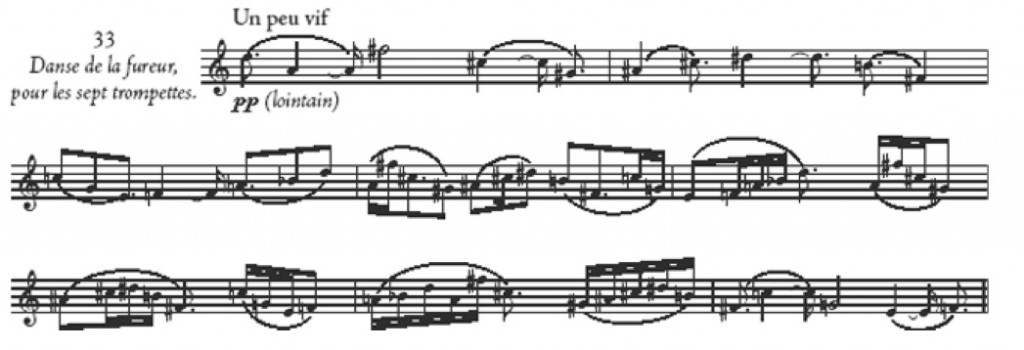***
But can you hear it?
Thomas Mann: Doctor Faustus: The Life of the German Composer Adrian Leverkühn as Told by a Friend (1947):
“I find,” he said, “that it is not to be.” “What, Adrian, is not to be?” “The good and noble,” he answered me; “what we call the human, although it is good, and noble. What human beings have fought for and stormed citadels, what the ecstatics exultantly announced—that is not to be. It will be taken back. I will take it back.” “I don’t quite understand, dear man. What will you take back?” “The Ninth Symphony,” he replied. And then no more came, though I waited for it.Q1. What does it mean to take (Beethoven’s) Ninth Symphony Back?
Pierre Boulez (b.1925)
Take a look at the Sonic Glossary entry for “Twelve-Tone Composition:”
Here is Pierre Boulez’s Structures 1a (1952), a piece of “total-serialism.”
[audio:http://www.jaimeoliver.pe/snd/mh/postwar/boulez.mp3]Not only does Boulez organize pitch using Schoenberg’s twelve-tone system, but he systematizes rhythm, dynamics and attacks along similar lines.
Q2.1 What is the affect of this kind of rigorous organization, or “pre-composition?”
Q2.2 Is there anything left for the composer to do?
Q2.3 It is impossible for the listener to hear the logic of composition unfold in time—what is the point if the music that is produced sounds almost random?
Luigi Nono (1924-1990)
Luigi Nono’s Il Canto Sospeso (1956) is also a twelve-tone composition. The piece is a musical setting of selected farewell letters written by European anti-fascists that were condemned to death.
Q3.1 How does this program affect the way that we hear the twelve-tone music?
The first movement is wholly instrumental (no voices). Fragmentation and fracture seem to be the themes here, and in general the sound is much less stable than the Boulez. The use of extreme registers and extended instrumental techniques is perhaps the principal cause of this destabilization:
Let’s listen:
[audio:http://www.jaimeoliver.pe/snd/mh/postwar/nono-01.mp3]Here is some information about the piece:
The ninth and final song of the collection uses the following text:
‘[…] I am not afraid of death […]’‘[…]I will be calm and at peace facing the execution squad. Are those who have condemned us equally at peace? […]’
‘[…] I go in the belief of a better life for you […]’ The text is scattered throughout the different voices of the choir; the words are cut up into single syllables and sung by various voices. This makes it difficult to hear the words. 3.2 How does this relate to the subject matter and to the fragments of text that Nono sets? Below is the song, the choir enters at around 2 minutes: [audio:http://www.jaimeoliver.pe/snd/mh/postwar/nono-09.mp3] 3.3 If you use a text with such a strong meaning is it still total serialism? Olivier Messiaen (1908-1992)
Quartet for the End of Time (1941)
In 1940, Messiaen was imprisoned in a camp in Germany. Whilst in captivity, he wrote the Quartet for the End of Time. It was performed in 1941 by Messiaen and three fellow prisoners to a crowd of 5000. The instruments that Messiaen had at his disposal were a (not in tune) piano, cello, violin and clarinet.
The piece is based on the text of Revelation. The following epigraph is in the score:
Then the angel that I saw standing on the sea and the land raised his right hand to heaven and swore by Him who lives for ever and ever, who created heaven and earth and the sea and everything in them: “There shall be no more time; when the seventh angel shall sound his trumpet, the hidden purpose of God will have been fulfilled, as he promised to his servants the prophets.” Revelation (10:5–6)The opening movement, “Liturgy of Crystal,” is prefaced by Messiaen with the following note:
Between three and four in the morning, the awakening of birds: a solo blackbird or nightingale improvises, surrounded by a shimmer of sound, by a halo of trills lost very high in the trees. Transpose this onto a religious plane and you have the harmonious silence of Heaven. Listen to the first movement and listen for the bird song. [audio:http://www.jaimeoliver.pe/snd/mh/postwar/mess-1.mp3]The clarinet represents the blackbird, the violin the nightingale.
Here are two videos of Messiaen explaining his use of bird song:
The third movement of the quartet, “Abyss of the Birds,” is again based on bird song. Here is a performance introduced by more talk from Messiaen:
The sixth movement, “Dance of Fury, for the Seven Trumpets,” has all the musicians playing in unison (they share the same melody). The piece exhibits Messaen’s interest in rhythm. A commonly used rhythmic idea of Messiaen’s was that of “non-retrogradable” rhythm. The rhythm, if reversed, would be the same as it s when played “forward.” Here is an example of this use of rhythmic palindromes:
[audio:http://www.jaimeoliver.pe/snd/mh/postwar/mess-6-excerpt.mp3]Now listen to the whole thing. Imagine how difficult it would be for the performers to play: the slightest wrong note would be obvious.
Q4.1 What does performing this kind of piece do to the performers? Are they able to express themselves, or do they become merely machines of reproduction?
The mechanistic quality of this piece contrasts to the others in the quartet. Without any birdsong (freedom, nature), it is perhaps the bleakest, in many ways foreshadowing the austerity of the total-serialism after the war.
[audio:http://www.jaimeoliver.pe/snd/mh/postwar/mess-6-full.mp3]